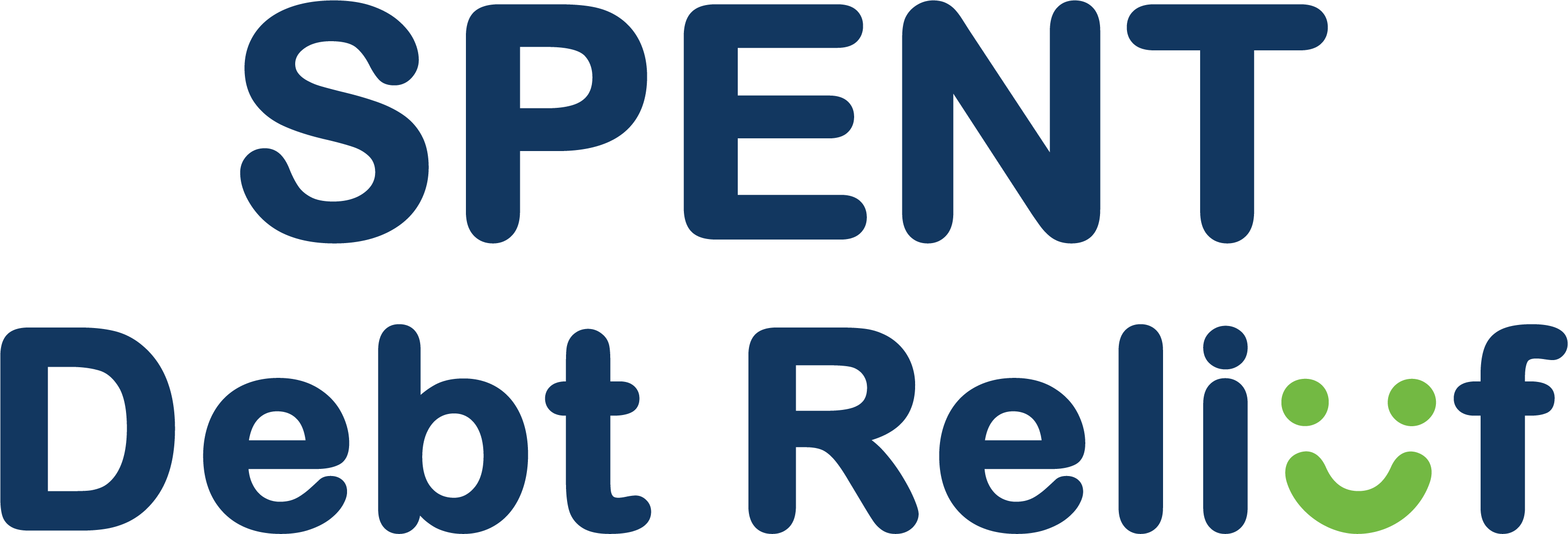In the fast-paced world of modern finance, managing debt can be a complex and overwhelming challenge. According to recent data from the Federal Reserve, as of the second quarter in 2023, U.S. consumer credit card debt reached a staggering $1.03 trillion. This statistic underscores the pressing need for effective debt management strategies. One approach gaining traction is debt settlement. In this blog, we will delve into the intricacies of debt settlement, its advantages and disadvantages, who can benefit from it, and how SPENT Law Group offers a tailored solution for those seeking financial freedom. To learn more or discuss your specific circumstances, contact our debt settlement attorneys at (855) 332-8457.
The Landscape of Debt in America
Before we dive into the specifics of debt settlement, it’s essential to understand the scale of the issue. As mentioned earlier, the Federal Reserve reported a total credit card debt of $1.03 billion in August 2023. This statistic highlights that millions of Americans are struggling with credit card debt. Another study revealed that approximately 47% of U.S. households carry credit card debt from month to month. This indicates that a substantial portion of the population is in need of effective debt management solutions.
What is Debt Settlement?
Debt settlement, also known as debt relief, is a financial agreement between a creditor and a debtor where the debtor pays a reduced amount that is considered as full payment of the outstanding debt. Essentially, it’s a negotiation process where the debtor, who is facing financial difficulties and unable to fulfill the full debt obligations, offers to pay a lump sum that is less than the total amount owed.
During the debt settlement process, the debtor may work with a debt settlement attorney, who will guide them through the steps. The debtor stops making direct payments to the creditor and instead, begins making payments into a savings account managed by the settlement attorney. Once enough funds are accumulated, the attorney negotiates with the creditor to accept a one-time payment that is lower than the total debt.
Debt settlement can offer relief and help avoid bankruptcy, but it does carry significant risks, including uncertain settlement outcomes and potential legal actions from creditors. It may also initially lower your credit score, as you are required to stop making payments to creditors. However, once the negotiated settlements are paid, your credit scores will begin to improve.
The decision to pursue debt settlement is intricate and requires careful consideration of all financial implications. Working with a skilled debt settlement attorney is crucial to effectively navigate the complexities of debt negotiation and secure the best possible settlement terms.

Decoding Debt Settlement: How It Works
The Process in Detail
Debt settlement is a strategic approach to managing and reducing unsecured debt, such as credit card balances. It involves negotiating with creditors to accept a lump-sum payment or monthly payments that are less than the total amount owed. This can provide relief for consumers struggling with high levels of debt.
How Settlements Are Reached
Negotiations are typically conducted by experienced attorneys, often affiliated with specialized firms like SPENT Debt Relief. Our attornies have a deep understanding of creditor practices and negotiation strategies. They work on behalf of our clients to achieve the most favorable settlement terms possible.
Understanding Creditor Perspectives
Creditors may be motivated to settle debts for various reasons. They understand that in some cases, receiving a partial payment is preferable to receiving nothing at all. Additionally, they may be willing to negotiate to avoid the costs and uncertainties that come with collection efforts.
The Pros and Cons of Debt Settlement
Pros:
- Significant Debt Reduction: Industry data indicates that on average successful settlements result in a 48% reduction of the original balance.
- Expedited Resolution: Compared to prolonged repayment plans, debt settlement offers a faster path to debt relief, potentially allowing consumers to resolve their debts in a matter of months rather than years.
- Immediate Financial Relief: Upon enrollment, consumers typically experience relief from creditor harassment and collection efforts, providing a crucial breathing space to regain control of their financial situation.
- Customized Payment Plans: Debt settlement programs, such as the one offered by SPENT Debt Relief, allow for tailored monthly payment plans that align with an individual’s current income and expenses.
- Legal Protection: With SPENT Law Group overseeing communications, consumers gain a layer of legal protection from creditor harassment, ensuring a smoother resolution process.
Cons:
- Credit Score Impact: It’s crucial to be aware that debt settlement can have a negative impact on credit scores. The process involves not paying the full amount owed, which is reflected in credit reports.
- Tax Implications: The IRS may consider the forgiven debt as taxable income, potentially leading to a tax liability for the debtor.
- No Guaranteed Outcome: Debt settlement outcomes are not guaranteed. While most creditors are open to negotiation, some may be less inclined to settle.
Who Should Consider Debt Settlement?
Individuals with Unmanageable Debt
Debt settlement is an option primarily for individuals facing a significant amount of unsecured debt, often exceeding $10,000. It’s particularly relevant for those who are struggling to make minimum monthly payments.
Those Experiencing Financial Hardship
If you’re facing a temporary financial setback, such as job loss, medical emergencies, or other unexpected expenses, debt settlement can provide much-needed relief.
Individuals with Limited Assets
For those with few assets that can be liquidated to pay off debts, debt settlement may be a more viable solution than bankruptcy.
Those Unable to Qualify for Consolidation Loans
Individuals with poor credit may find it challenging to qualify for debt consolidation loans. In such cases, debt settlement offers an alternative path to debt relief.
How to Know if Debt Settlement is Right for You
Assess Your Financial Situation
Begin by conducting a thorough assessment of your finances. Calculate your total debt, including credit card balances, medical bills, and other unsecured loans. Take stock of your monthly income and expenses to determine if debt settlement is a viable option.
Evaluate Alternatives
Consider other debt-relief options, such as debt consolidation, debt management plans, or bankruptcy. Compare the pros and cons of each to make an informed decision. You can explore all of your debt relief options here.
Seek Professional Guidance
Consulting with a reputable debt settlement firm, like SPENT Debt Relief, can provide invaluable insights. Our experts can assess your specific situation and advise on the best course of action.
The SPENT Debt Relief Process
At SPENT Debt Relief, we understand the challenges that consumers face when dealing with credit card debt. Our personalized process is designed to provide effective solutions tailored to your unique financial situation.
Step One: Enroll in our Program
The journey begins with a free consultation. You can reach us at (855) 332-8457 or fill out our online form. During this consultation, our dedicated debt specialists will review your financial situation and credit history to ensure you qualify for the SPENT Debt Relief Program. Rest assured, there is no risk or obligation to you at this stage. We only charge fees once we successfully reduce your enrolled debt.
Step Two: Build Your Savings
Following enrollment, you’ll work closely with your assigned debt specialist to craft a monthly payment plan tailored to your budgetary constraints. These payments are securely deposited into an FDIC insured savings account, which will be established in your name during the enrollment process. This ensures that you maintain complete control over your funds at all times.
Step Three: Credit Communications
Once enrolled, our legal team takes over communication with your creditors. We request them to cease all direct contact with you, ensuring a more peaceful process moving forward. All future interactions will be handled by SPENT Law Group.
Step Four: Debt Reduction
As your savings grow, we initiate negotiations with your creditors to achieve reductions in your outstanding balances. We keep you informed every step of the way, notifying you whenever a settlement agreement is reached. While results may vary based on individual circumstances, industry averages suggest successful settlements often range between 40% to 60% of the original debt amount.
Step Five: Graduation
Upon your approval of a settlement offer, SPENT Law Group facilitates the transfer of funds from your trust account to your creditors, effectively satisfying the debt. This process is repeated until all enrolled debts have been successfully reduced and paid off, marking the culmination of your journey with SPENT Debt Relief.
In a financial landscape fraught with challenges, debt settlement emerges as a viable strategy for individuals burdened by credit card debt. The SPENT Debt Relief Program, with its meticulous process and dedicated team, offers a tailored approach to help consumers regain control of their financial future. Contact us today for a complimentary consultation to find out if debt settlement is the best path for you.
| The SPENT Debt Relief Process | Description |
|---|---|
| Enroll in our Program | Free consultation to assess financial situation. Fees only charged upon successful debt reduction. |
| Build Your Savings | Create tailored monthly payment plan within budget. Funds deposited into FDIC insured savings account under your control. |
| Credit Communications | SPENT Law Group manages creditor communication, halting direct contact with you. |
| Debt Reduction | Negotiate with creditors to reduce outstanding balances. Receive updates on settlements reached, typically between 40% to 60% of original debt amount. |
| Graduation | Upon settlement approval, transfer funds from trust account to creditors, satisfying debt. Process continues until all enrolled debts are successfully reduced and paid off. |

